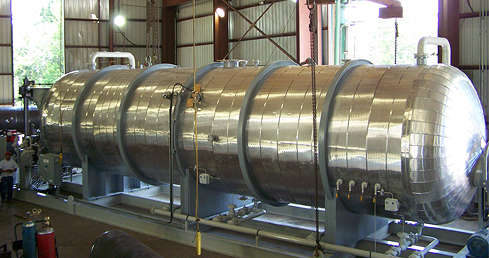Produced Water Treatment
| The production of oil and gas results in significant quantities of water especially when the wells are nearing maturity. The water must be separated from the oil and gas and be disposed of properly to prevent adversely affecting the environment. Disposing of the water may involve reinjection of the water into the well for disposal or to maintain reservoir pressure. Sometimes the produced water may be disposed onshore or discharged offshore. |
SPEC offers a variety of technologies and equipment to meet varying concentration requirements for the proper discharge of produced water. SPEC can design systems required for:
- Onshore discharge
- Offshore discharge
- Well reinjection
- Steam Production

Hydrocyclones are used to separate liquids of different densities by exploiting centrifugal forces. When sufficient process pressure is available, hydrocyclones are typically installed upstream of other water treatment equipments such as the IGF to provide preliminary separation. The hydrocyclone is a vessel consisting of "liners". The liners are centrifugal devices with no moving parts used to separate the liquids of different densities, often free oil from water. The fluid to be treated is directed tangentially into the hydrocyclone which causes it to swirl. The spinning motion creates strong centrifugal forces which makes the two immiscible liquids, to separate. Due to the difference in densities of the two liquids the heavier liquid is forced outward toward the wall of the hydrocyclone tube (liner) and the lighter liquid is displaced towards the center where it forms a core. By controlling the pressure across the tube the lighter liquid is forced to flow through the overflow and the heavier liquid is directed to the underflow. SPEC's designed and manufactured hydrocyclones provide the following advantages.
- Range of materials and sizes depending on application
- No moving parts
- Minimal maintenance
- Efficient design
- Customized and Standard Vessel Sizes
- Complete skid mounted packages
- ASME coded vessels
- Can deliver as low as 25 ppm oil in water concentration
Corrugated Plate Interceptors (CPI)
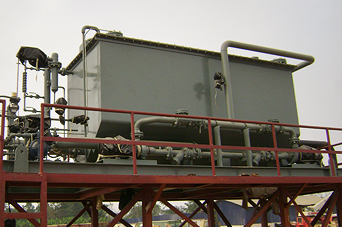 |
When sufficient process pressure does not allow for the use of hydrocyclone units, the CPI is an effective and economical alternative. It is used in industrial wastewater, industrial filtration, oillwater separation clarificationlseparation, and storm water and sewer overflow applications. The unit's gravity design separates light from heavy materials in a smooth, automatic flow. SPEC CPI's use plate packing to improve free oil removal. SPEC's designed and manufactured CPI provide the following advantages: |
- Range of sizes depending on need
- No moving parts
- Minimal maintenance
- Lower capital investment
- Handles surges/slugs of oil without hampering performance
- Complete skid mounted packages
- API standard
- Can deliver as low as 50 ppm oil in water concentration
DAF systems are used to remove suspended solids and liquids (such as oil) from water. To achieve separation, water saturated with air is pressurized and then introduced into an atmospheric floatation tank containing the produced water to be treated. The equalizing pressure causes the air to be released resulting in bubbles. These bubbles stick to the suspended particles and cause them to float to the surface. Once at the surface, the particles are skimmed off.
Process Description
A portion of treated produced water leaving the DAF tank is recycled and pumped to an air drum where the compressed air is introduced to the water. Sufficient air is introduced to ensure the water is air saturated. This air saturated water is then sent to the front floatation tank. When the water saturated with air is introduced to the floatation tank, tiny air bubbles are released. These air bubbles attach themselves to the particles that are to be removed causing them to rise to the surface of the tank. A skimmer or weir plate is utilized to segregate suspended particles and treated water. Typically, chemicals are injected into the feed water to flocculate the suspended particles. Additionally, natural gas may be used instead of air depending on the application and location of the facility. SPEC's designed and manufactured DAF systems provide:
Efficient design
- Quick Start-Up and able to handle periodic stoppage
- Customized and standard packages
- Complete skid mounted packages
- ASME coded vessels
- Up to 90% removal of effluent and solid removal
- Minimal Chemical Usage
- Screw conveyor available for heavy solid removal
Induced Gas floatation is one of the various technologies available for the removal of oily particles contained in produced water. The main purpose of the IGF unit is to separate free oil from water. In this equipment, fuel gas is induced in the oily water in the form of tiny bubbles which are generated from a pumping device. The tiny bubbles attach to suspended oil droplets causing them to float.
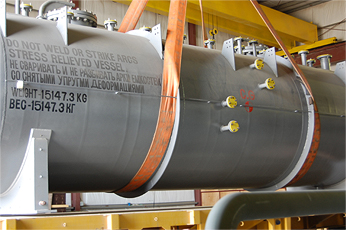 |
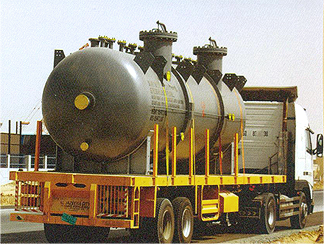 |
This unit is a dispersed gas and coalescent produced water clarifier. It operates by dispersing natural gas (as fine bubbles) in the total produced water stream by means of a differential pressure induction system. This system utilizes recirculation pumps to pressurize the water manifold that supplies the venturo eductors. As the pressurized water flows through the venturo eductros blanket gas is induced into and mixed in the water. The waterlgas mixture is ejected from the venturo eductor bottoms(s). The resulting small bubbles rise through the effluent stripping entrained oil. As the gas rich effluent proceeds it flows through the coalescing screens, which enhance oil removal. The stripped oil rises to the surface or froth. The froth is propelled over the oil bucket-skimming weir by the internal vessel hydraulics.
This unit has two electric motor driven produced water recirculation pumps. These pumps circulate design flowrate based on the inflow flowrate. There are two double diaphragm pumps for the recovered oillcondensate. They transport the oillcondensate to the wet oil tank or heater treater. These units utlize Venturo Eductor assemblies. They are individually accessible through the water manifold top. Each VE is comprised of an upper and lower eductor tube, a VE nozzle and a static mixer. The VE's are easily removed.
Optional Coalescer Pack Equipped IGF
To aid the separation process the IGF is equipped with coalescer packs and diverter plates. Usually, IGF vessels are internally broken down into compartments with each compartments consisting of eductors, coalecser pack and diverter plate. The IGF is also equipped with a deflector plate and an oil bucket. See IGF internal layout drawing for further visual clarification.
I. Diverter Plates:, These plates seperate the IGF compartments. Each separation compartment consists of a pair of eductors and a coalescer pack. The diverter plates not only separate the compartments but also allow the fluid to flow in a predetermined manner. This increases the retention time which aides the proper removal of the free oil particles.
II. Eductors: The eductors are static jet pumps which uses water as a motive force to induce gas bubbles into the oily water. The bubbles assist the oil particles to coalesce to form bigger particle which float to the surface to form an oil film.
III. Coalescer Pack: Each compartment has a coalescer pack to further assist the formation of larger oil particles. The pack achieves this by increasing the contact surface area of the fluid thus allowing more free oil particles to come together. There are several types of coalescer packs. The plate type is used for this project.
IV. Deflector Plate: The deflector plate is installed in the vessel with an inclination to force the oil film into the oil bucket. Since oil will float on water restricting the oil film to a portion will create a thicker oil film which can be skimmed into the oil bucket.
SPEC's designed and manufactured IGF units provide:
- Customized and Standard Packages
- Vertical and Horizontal Options
- ASME coded vessels
- Minimal or no moving parts
- Optional coagulant chemical injection
- Optional impeller or sparger design - Skid mounted packages
- Can deliver as low as 10 ppm
- Oil in water concentration
For most applications, first and second stage separation units are sufficient to meet the regulatory discharge requirements. However, when the discharge requirements are more stringent and require lower concentration of oil in water, nutshell filters are utilized. Nutshell filters use a mixture of nutshells as the filter media. Nutshells allow for the oil to collect on the surface of the nutshells while also being able to capture solids.
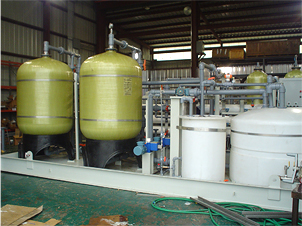
Process Description
The nutshell filters have a simple process. Oily water enters the vessel where it passes through the nutshells under pressure. The oil and solids get trapped within the filters and the clean water exits the bottom of the vessel. To remove the oil and solids from the filter media, a backwash process is used. The backwash process consists of fluidizing the bed, removing the contaminated water, allowing the filter to settle and finally rinsing the filters to remove any contaminates that may still be present. The process uses at least two filters: one filter online and the second filter is being regenerated and on standby. Depending on your process requirements, SPEC can determine the appropriate number of filters required to provide the most optimized design. SPEC designs and manufactures nutshell filters that provide the following advantages:
- Efficient design
- Skid mounted packages
- Pecan and walnut shell blend
- High solids removal efficiency
- Process water used for backwash eliminating need for clean water source
- ASME coded vessels
- Can deliver as low as 5 ppm oil in water concentration

